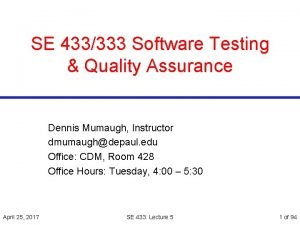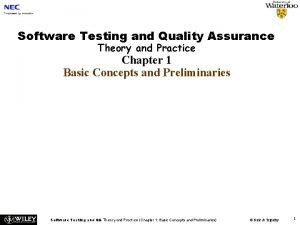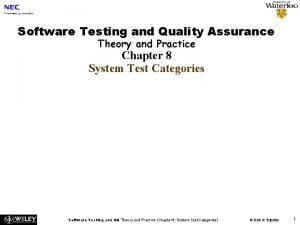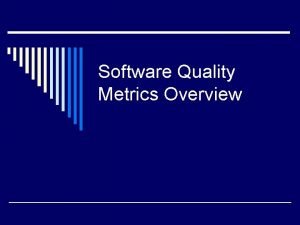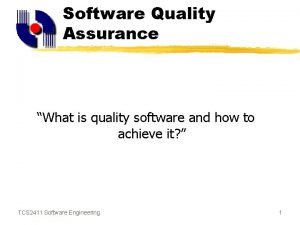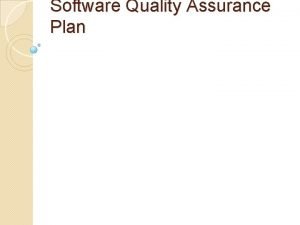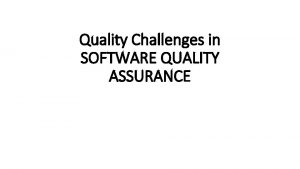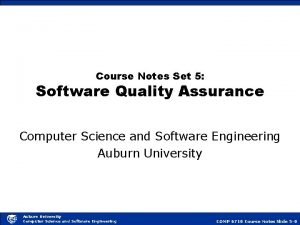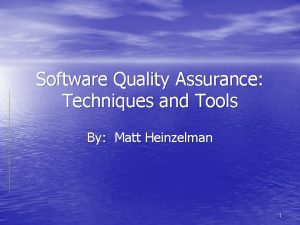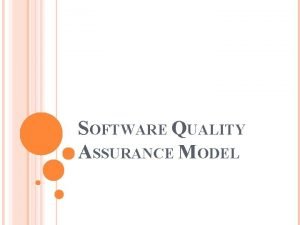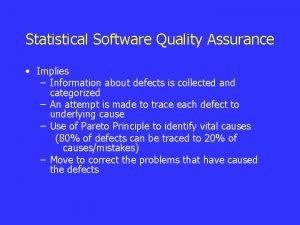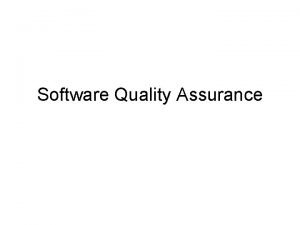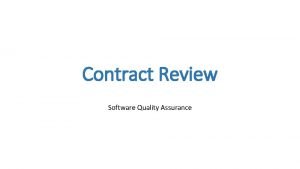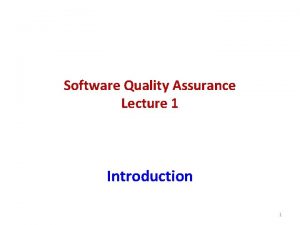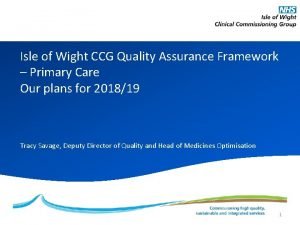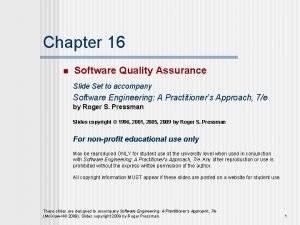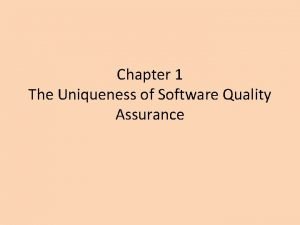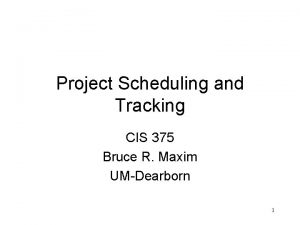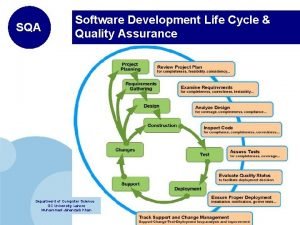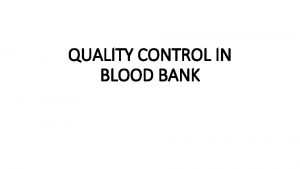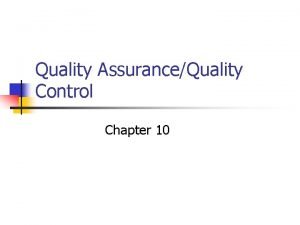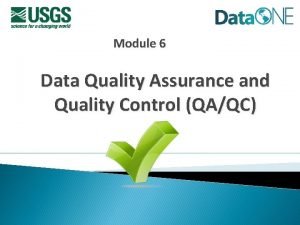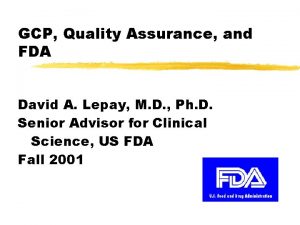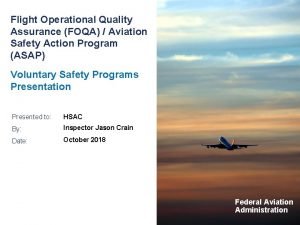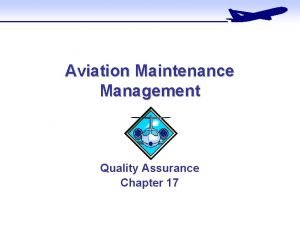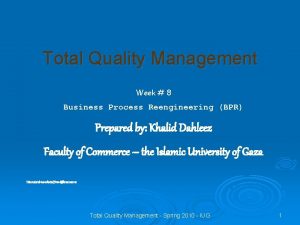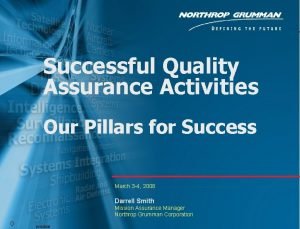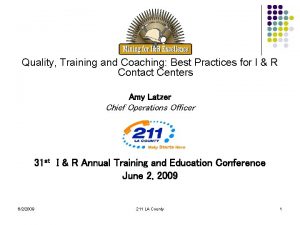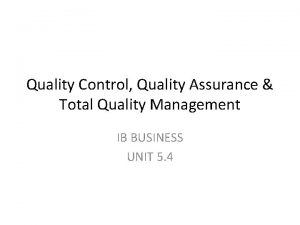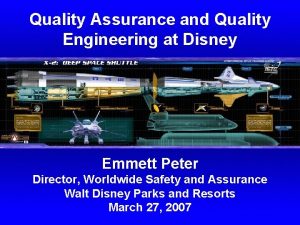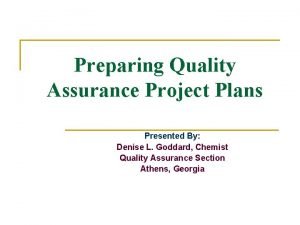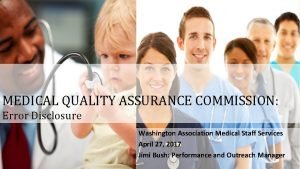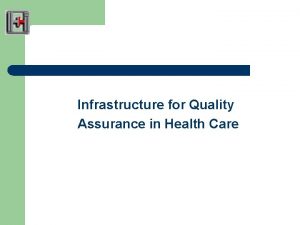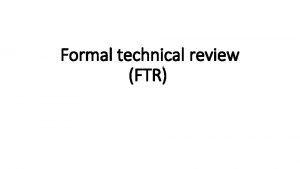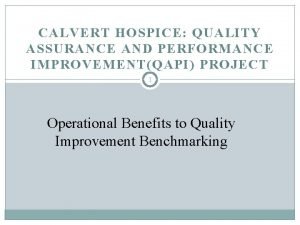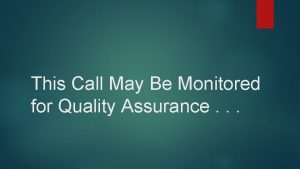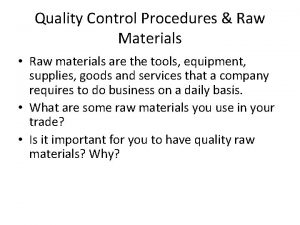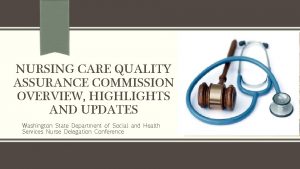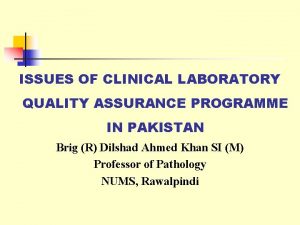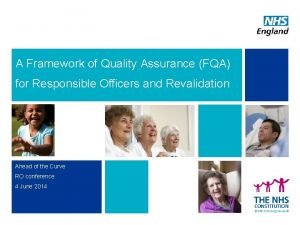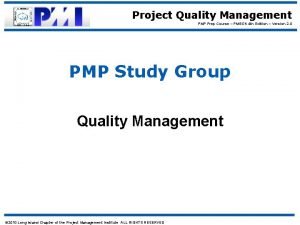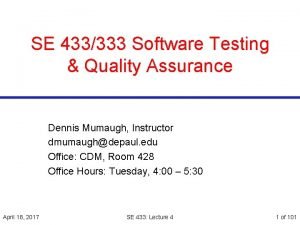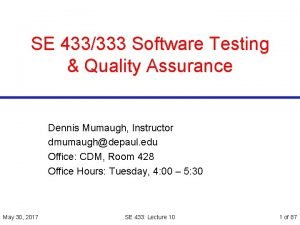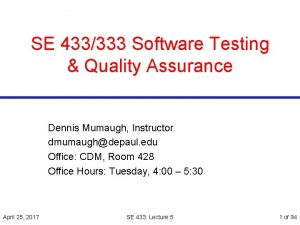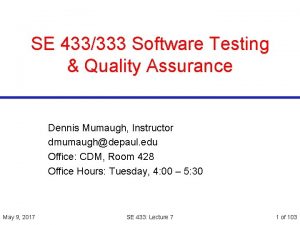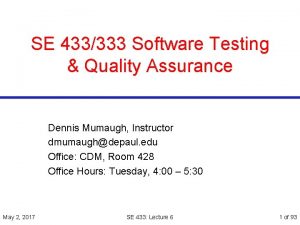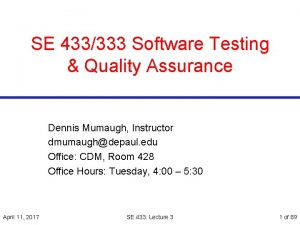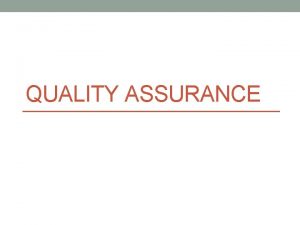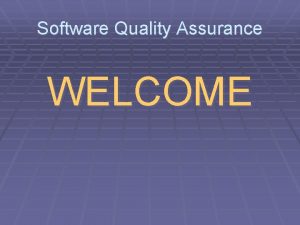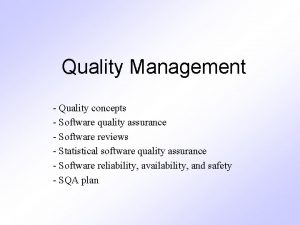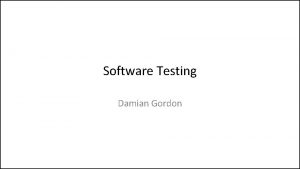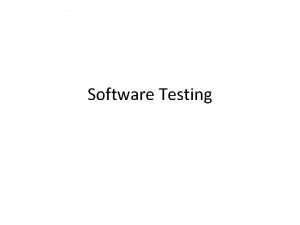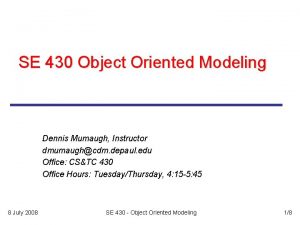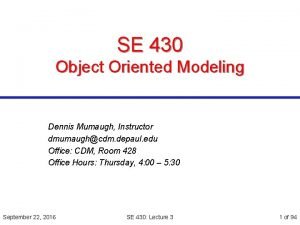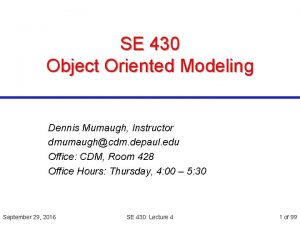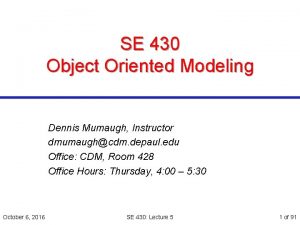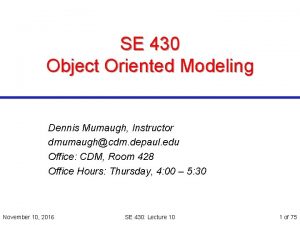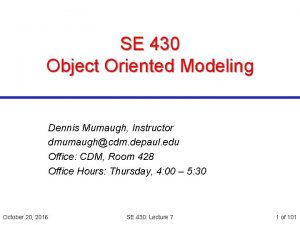SE 433333 Software Testing Quality Assurance Dennis Mumaugh




















































































- Slides: 84

SE 433/333 Software Testing & Quality Assurance Dennis Mumaugh, Instructor dmumaugh@depaul. edu Office: CDM, Room 428 Office Hours: Tuesday, 4: 00 – 5: 30 April 4, 2017 SE 433: Lecture 2 1 of 84

Administrivia § Comments and feedback § Announcements Ø Ø Mailing list is up and running [latest update was Monday at 4: 00 pm]. List of assignments posted see slide 4 Assignment info: » http: //docs. oracle. com/javase/8/docs/api/java/util/Scanner. html – The scanner class used in assignments Assignment 1, Part II – requires a partner. Those who do not have a partner can use the mailing list to find one. April 4, 2017 SE 433: Lecture 2 2 of 84

SE 433 – Class 2 Topic: Software Quality Reading: Chapters 1 -4 of the textbook. Articles on the Class Page and Reading List April 4, 2017 SE 433: Lecture 2 3 of 84

Assignments § Assignment 1 Triangle Assignment 1, Part 1 Due Apr 4 Ø Assignment 1, Part 2 Due Apr 11 Assignment 2: Software Quality Due Apr 11 Assignment 3: JUnit & Eclipse Due Apr 18 Assignment 4: JUnit, Parameterized Tests Due Apr 25 Assignment 5: Black Box Testing, Part 1: Design Due May 2 Assignment 6: JUnit & Ant Due May 4 Assignment 7: Black Box Testing, Part 2: Implementation Due May 11 Assignment 8: White Box Testing Due May 16 Assignment 9: White Box Testing & Code Coverage Due May 30 Final Paper Due Jun 6 Ø § § § § § April 4, 2017 SE 433: Lecture 2 4 of 84

Assignment 2: Software Qualities § Due date: April 11, 2017, 11: 59 pm Ø Improving the quality of service of your system [Note Assignment 1, Part II is also due on April 11, 2017, 11: 59 pm] April 4, 2017 SE 433: Lecture 2 5 of 84

Assignment 3 -9 In preparation for the rest of the assignments, locate and load the following software: Ø Ø Ø Java Eclipse Ant Junit Cobertura See the reading list for where to locate the software to down load and also the documentation and such. Google is your friend. After loading, test it out. April 4, 2017 SE 433: Lecture 2 6 of 84

Assignments § Read the assignment at least twice § Make sure your name and section and assignment is on the document and each file § Note on the submission if you had problems, or were late (and had permission). April 4, 2017 SE 433: Lecture 2 7 of 84

Thought for the Day Software failure has caused more than inconvenience. Software errors have caused human fatalities. The causes have ranged from poorly designed user interfaces to direct programming errors. April 4, 2017 SE 433: Lecture 2 8 of 84

Software Quality "Quality must be built in at the design stage. It may be too late once plans are on their way. " – W. Edwards Deming April 4, 2017 SE 433: Lecture 2 9 of 84

Factors in Project Success & Failure April 4, 2017 SE 433: Lecture 2 10 of 84

Software Crisis § Many software-related failures: auto-pilot systems, air traffic control systems, banking systems, IRS. Ø On January 15, 1990, the AT&T long-distance telephone network broke down, interrupting long-distance telephone services in US for over 8 hours. [Missing break in a switch statement. ] Ø On June 4, 1996, the maiden flight of the new and improved Ariane 5 rocket exploded 37 seconds after liftoff. Ø On June 8, 2001, a software problem caused the NYSE to shut down the entire trading floor for over an hour. Ø Many, many more. April 4, 2017 SE 433: Lecture 2 11 of 84

What is the problem? Software Projects have a terrible track record A 1995 Standish Group study (CHAOS) [see notes] found that only 16. 2% of IT projects were successful in meeting scope, time, and cost goals (on-time & on-budget) [Things have improved a bit since. ] Over 31% of IT projects were canceled [never seeing completion], costing over $81 billion in the U. S. alone They never worked Too late for the market window Most projects are Late in delivery Missing functionality Have major defects (bugs) Did not do what the customer wanted Hard to maintain and support April 4, 2017 SE 433: Lecture 2 12 of 84

Chaos Report 2012 Project Success: Type 1. The project is completed on-time and onbudget, with all features and functions as initially specified. (2012: 39%) Project Challenged: Type 2. The project is completed and operational but over-budget, over the time estimate, and offers fewer features and functions than originally specified. (2012: 43%) Project Impaired: Type 3. The project is canceled at some point during the development cycle. (2012: 18%) (Are ALL impaired projects failures? ? ? ) April 4, 2017 SE 433: Lecture 2 13 of 84

A Case Study The Initial Launch of Health. Care. gov (2013) April 4, 2017 SE 433: Lecture 2 14 of 84

ACA – Health. Care. gov § ACA signed into law on March 23, 2010 § Health. Care. gov is a healthcare exchange website. Ø Ø “One-stop shopping sites for health insurance” CBO forecast: 7 million users during the first year § Development contracts awarded in September 2011 Ø Ø No-bid, cost-plus contracts Pre-certified private contractors § Health. Care. gov launched on October 1, 2013 Ø April 4, 2017 Serious technological problems SE 433: Lecture 2 15 of 84

Health. Care. gov – The Launch Problems § Performance: response time (landing page) > 8 s Ø § § § “Maddeningly long wait times" Navigation: broken UI Stability: intermittent crashes, availability ≈ 43% Functionality: incorrect and incomplete data Error rate (per page) ≈ 6% Scalability: < 1, 100 concurrent users Enrollment completion rate < 30% April 4, 2017 SE 433: Lecture 2 16 of 84

Health. Care. gov – The Contractors & The Cost § The lead contractor: CGI Group Ø Ø At least 47 private companies involved Including QSSI, Equifax, Serco § Coordinated by the Centers for Medicare and Medicaid Services (CMS) § Total budget: $293 million Ø Ø CGI: $196 million (2013). $112 million paid Oct. 2013 QSSI: $85 million § Estimated actual cost: > $500 million by Oct. 2013 April 4, 2017 SE 433: Lecture 2 17 of 84

Health. Care. gov – The Failures – Software Eng. § Inadequate Testing Ø Ø Ø Ø April 4, 2017 “This system just wasn't tested enough. ” – CMS Full test began T -2 weeks (time before launch). Final “pre-flight checklist” T -1 week: 41 of 91 functions fail. No “end-to-end” test as late as T -4 days Stress tests T -1 day: performance degradation with only 1, 100 concurrent users. (50, 000 -60, 000 expected) Final top-to-bottom security tests not finished. No integration test. No beta test. SE 433: Lecture 2 18 of 84

Health. Care. gov – The Failures – Software Eng. § Evolving, Rolling Requirements Ø Ø Ø Regulations and policies were still in flux when contracts awarded in 2011. The specifications for the project were delayed repeatedly. The regulations and policies were modified repeatedly until summer 2013. Repeated changes result in design changes. CGI did not start coding until Spring 2013 § Failure to Effectively Manage Changes Ø Ø Ø “Write-down-all-the-requirements-then-build-to-those-requirements” Did not adopt an agile development approach. Committed to an all-or-nothing launch date. April 4, 2017 SE 433: Lecture 2 19 of 84

Case Study: Health. Care. gov– Mc. Kinsey “Red Team” Assessment April 4, 2017 SE 433: Lecture 2 20 of 84

Case Study: Health. Care. gov: The Failures – Management § Management expertise is in getting contracts not delivering projects. § Project quality is sacrificed for the sake of appearances. § Seriously substandard staffing and under staffing Ø CGI. Three months before launch, only 10 developers were working on a crucial part of the site , and of those, only one was "at a high enough skill level. ” § Lack of coordination among contractors Ø April 4, 2017 Unclear responsibilities. Fragmented authority. SE 433: Lecture 2 21 of 84

Case Study: Health. Care. gov: The Failures – Gov. & Policies § Government IT projects Ø Ø Most are over budget and/or behind schedule. “Write-down-all-the-requirements-then-build-to-those-requirements” is outdated. § IT procurement policies Ø Ø Cost-plus contract, no-bid contracts “The firms that typically get contracts are the firms that are good at getting contracts, not typically good at executing on them. ” April 4, 2017 SE 433: Lecture 2 22 of 84

Case Study: Health. Care. Gov – Dec. 2013 § 400+ bug fixes, by the end of Nov. 2013 Ø § § § “Operate smoothly for most users. ” – W. H. Availability > 90% Response time (landing page) < 1 s Error rate (per page) < 1% Completion rate ≈ 80% System capacity ≈ 50, 000 concurrent users Sign-ups Ø April 4, 2017 27, 000 in Oct, 110, 000 in Nov, 975, 000 in Dec SE 433: Lecture 2 23 of 84

Case Study: Health. Care. Gov – April 2014 § Issues on data accuracy and completeness Ø Ø Estimated 10 -15% of sign-ups missing 834 Other inaccuracies have been reported § CGI work during repair continue to be substandard Ø Half of the software fixes failed. – CMS § CGI contract has been terminated. (Jan. 10, 2014) § March 31, 2014 (last day to sign up), site went down § April 1, 2014. 7. 1 million signed up – W. H. April 4, 2017 SE 433: Lecture 2 24 of 84

Case Study: Health. Care. Gov – Aftermath § Accenture took over in Jan. 2014 as the lead contractor for development and maintenance: $175 M Ø Cost of building the system – GAO, July 2014 Ø $834 M through Feb. 2014 » Total estimated cost: > $2 B Ø Ø Ø “CMS undertook the development of Health. Care. gov without effective planning or oversight practices” Also found “increased and unnecessary risk of unauthorized access, use, disclosure, modification or loss” of information CMS only withheld $267, 000 in requested fees, 2% of the contract, from CGI. April 4, 2017 SE 433: Lecture 2 25 of 84

Case Study: Health. Care. Gov – 2015 Enrollment Cycle § Enrollment for 2015 (37 states) Ø Ø Ø Nov 15, 2014 – February 15, 2015. Outages on the first day More smooth operation thereafter § February, 2015 Ø Ø ~ 11. 4 million sign-ups (~8. 6 million re-enrollments) » Open enrollment extensions: March 15 – April 30 ~800, 000 received incorrect tax information, » Incorrect amount on 1095 -A Form April 4, 2017 SE 433: Lecture 2 26 of 84

Case Study: Health. Care. gov: The Lessons Learned § Adopt software engineering best practices Ø Ø Agile software development. Testing early. Software quality assurance and testing. Testing throughout. § Adopt management best practices Ø Ø Clear responsibility and accountability Performance metrics and progress tracking § Revamp government IT procurement policies Ø Ø April 4, 2017 Current system is antiquated, and has failed. Bring government IT to the 21 st century. SE 433: Lecture 2 27 of 84

Software Reliability April 4, 2017 SE 433: Lecture 2 28 of 84

Metrics of Software Quality – Performance & Scalability § Performance Ø Ø The ability to complete requested functions or services within the expected time span by the users. e. g. , average response time for a given task § Scalability Ø Ø The capacity of a system to handle increasing load or demand. e. g. , # of concurrent users, # of transactions per second, # of requests per second April 4, 2017 SE 433: Lecture 2 29 of 84

Product Quality Metrics § Two key metrics for intrinsic product quality are Mean Time To Failure (MTTF) and availability § MTTF is most often used with safety critical systems such as air traffic control systems, avionics, and weapons § Availability is the probability that a system will work as required when required during the period of a mission. § Both are correlated, but different in the same way that failures and defects are different April 4, 2017 SE 433: Lecture 2 30 of 84

Metrics of Software Quality – Mean Time Between Failures § Mean time between failures (MTBF) Ø Average of intervals between consecutive failures. § Mean time to failures (MTTF) Ø Synonymous to MTBF § Mean time to repair (MTTR) Ø Average time to repair/restart the system and get it back to running April 4, 2017 SE 433: Lecture 2 31 of 84

Metrics of Software Quality – Availability & Reliability § Availability The probability of a system to be available. Ø The fraction of time the system is available time (“up time”) total time Ø § Reliability The probability of a system to operate without failures. Ø The fraction of all attempted operations that complete successfully. # of successful operations # of total operations attempted Ø April 4, 2017 SE 433: Lecture 2 32 of 84

Software Reliability A simple measure of reliability is mean-time-between-failure (MTBF), where MTBF = MTTF + MTTR § The acronyms MTTF and MTTR are mean-time-to-failure and mean-time-to-repair, respectively. § Software availability is the probability that a program is operating according to requirements at a given point in time and is defined as Availability = [MTTF/(MTTF + MTTR)] x 100% § Consider 5 nines reliability (99. 999%); what does this mean? Ø 5 minutes of down time per year [See Availability (system) – https: //en. wikipedia. org/wiki/Availability_(system)] April 4, 2017 SE 433: Lecture 2 33 of 84

Metrics of Software Quality – Error Rate & Completion Rate § Reliability depends on the unit of operation Ø Ø An operation may consists of multiple steps Reliability ≠ Completion rate § Error rate (per page) Ø The fraction of pages (unit of operation) that time out or fail § Completion rate Ø Ø April 4, 2017 The fraction of all attempted operations that eventually complete the operation Completion ≠ Success SE 433: Lecture 2 34 of 84

Integration & System Testing § Integration testing Ø To expose defects in the interfaces and the interactions between integrated sub-systems. § System (“end-to-end”) testing Ø Test of an integrated system to determine whether it meets the specification. April 4, 2017 SE 433: Lecture 2 35 of 84

Acceptance & Beta Testing § Acceptance testing Ø Ø To determine whether or not a system satisfies the user needs and requirements. To enable the user, customers, or other authorized entity to determine whether or not to accept the system. § Beta testing Ø Ø Ø April 4, 2017 One form of acceptance testing Performed by real users in their own environment Perform actual tasks without interference. SE 433: Lecture 2 36 of 84

The Spectrum of Software Quality April 4, 2017 SE 433: Lecture 2 37 of 84

What is Quality? Some possible definitions: § Quality = zero defects (Crosby) § The totality of features and characteristics of a product or service that bear on its ability to satisfy specified or implied needs. (ISO) § Quality = fitness for purpose (Juran) § Quality n. , the degree of excellence (OED) April 4, 2017 SE 433: Lecture 2 38 of 84

Software System Qualities § Correctness § Availability § Reliability § Performance § Scalability § Efficiency § Safety April 4, 2017 § Usability § Security § Robustness § Maintainability § Reusability § Portability § Interoperability SE 433: Lecture 2 39 of 84

On Expected Behavior – Correctness vs. Reliability § Correctness Ø Whether a system is consistent with its specification. § Reliability Ø The probability of a system to operate without failures. Ø Relative to its specification and a usage profile. Ø Statistical approximation to correctness 100% reliable ≈ correct April 4, 2017 SE 433: Lecture 2 40 of 84

On Exceptional Behavior – Safety vs. Robustness § Safety Ø The ability of a software system to prevent certain undesirable behaviors, i. e. , hazards. § Robustness Ø The ability of a software system to fail or degrade gracefully outside its normal operating parameters. Ø Acceptable (degraded) behavior under extreme conditions. April 4, 2017 SE 433: Lecture 2 41 of 84

Focusing on – Different Facets of the System § Correctness, reliability: Ø Let traffic pass according to correct pattern and central scheduling § Robustness, safety: Ø April 4, 2017 Provide degraded function when possible » never signal conflicting greens. » blinking red / blinking yellow is better than no lights » no lights is better than conflicting greens SE 433: Lecture 2 42 of 84

Relationship Among the Qualities reliable but not correct: failures occur rarely robust but not safe: catastrophic failures can occur Robust Reliable Correct safe but not correct: annoying failures can occur correct but not safe or robust: the specification is inadequate April 4, 2017 Safe SE 433: Lecture 2 43 of 84

Performance Related Qualities § Performance The ability to complete requested functions or services within the expected time span by the users. § Scalability Ø The capacity of a system to handle increasing load or demand. § Efficiency Ø The ability to make maximum and efficient use of system resources. Ø April 4, 2017 SE 433: Lecture 2 44 of 84

Usability & Security § Usability The ability for the users to use all the features of the system without special efforts. § Security Ø The ability to maintain integrity of the system operation and the data. Ø April 4, 2017 SE 433: Lecture 2 45 of 84

Internal Qualities § Maintainability Ø The ability to make changes, enhance, adapt, and evolve a software system over a long period of time. § Reusability Ø The ability to use parts of the system in different project without special effort on the part of the developers § Portability Ø The ability to port a software system to a different platform or operating environment April 4, 2017 SE 433: Lecture 2 46 of 84

Software Quality Conformance to customers’ requirements April 4, 2017 SE 433: Lecture 2 47 of 84

Quality § The American Heritage Dictionary defines quality as Ø “a characteristic or attribute of something. ” § For software, two kinds of quality may be encountered: Ø Ø Ø Quality of design encompasses requirements, specifications, and the design of the system. Quality of conformance is an issue focused primarily on implementation. user satisfaction = compliant product + good quality + delivery within budget and schedule April 4, 2017 SE 433: Lecture 2 48 of 84

Cost of Quality § Prevention costs include Ø Ø Quality planning Formal technical reviews Test equipment Training § Internal failure costs include Ø Ø Ø Rework Repair Failure mode analysis § External failure costs are Ø Ø Complaint resolution Product return and replacement Help line support Warranty work April 4, 2017 SE 433: Lecture 2 49 of 84

Customers’ Expectations § What’s wrong with “performance to customers’ expectations” rather than requirements? § Often hear people say “We must exceed the customers’ expectations!” § What’s the basic problem with this? § The result is? April 4, 2017 SE 433: Lecture 2 50 of 84

Software Quality § Conformance to explicitly stated functional and performance § § requirements, explicitly documented development standards, and implicit characteristics that are expected of all professionally developed software. Quality must be defined and measured if improvements are to be achieved In the narrowest sense, it is commonly recognized as the lack of “bugs” in the product Also, the most basic meaning of conformance to requirements because if the software contains too many functional defects, the basic requirement of providing the desired function is not met How is this usually expressed? April 4, 2017 SE 433: Lecture 2 51 of 84

Application to Software § Simplistically, software product quality is lack of “bugs” in the product § Why is this problematical for software systems? Ø Ø Ø Correct operation is not sufficient – performance? Usability by the end-user Software specifications April 4, 2017 SE 433: Lecture 2 52 of 84

Software Quality § The collection of attributes in a software system, the level of the attribute for which the customer and users holds a positive value. § It is best defined as “conformance to customers’ requirements” April 4, 2017 SE 433: Lecture 2 53 of 84

Cost of Software Defects April 4, 2017 SE 433: Lecture 2 54 of 84

Saving Time and Money § Even experienced software engineers inject a defect about every ten lines of code § The cost of finding and fixing defects increases at every step in the development process § The defect find & fix times range from 3 minutes in code reviews to 25 minutes in inspections and 1400 minutes in system testing § For accurate plans and reliable commitments, you must insist on what? April 4, 2017 SE 433: Lecture 2 55 of 84

Cost of Software Defects April 4, 2017 SE 433: Lecture 2 56 of 84

Estimated Cost of Fixing Defects The earlier a defect is discovered, the lower the cost of fixing the defect. April 4, 2017 SE 433: Lecture 2 57 of 84

Distribution of Defects – Time Introduced and Fixed § Majority of defects are introduced early § Majority of defects are discovered late. April 4, 2017 SE 433: Lecture 2 58 of 84

Cost by Development Phases April 4, 2017 SE 433: Lecture 2 59 of 84

Software Verification and Validation (V&V) April 4, 2017 SE 433: Lecture 2 60 of 84

Verification and Validation § Verification Does the software system meet the requirements specifications? Are we building the software right? § Validation Does the software system meet the user's real needs? Are we building the right software? April 4, 2017 SE 433: Lecture 2 61 of 84

Software Specification A document that specifies, ideally in a complete, precise and verifiable manner, the requirements, design, behavior, or other characteristics of a component or system, and, often, the procedures for determining whether these provisions have been satisfied. [IEEE] April 4, 2017 SE 433: Lecture 2 62 of 84

Validation vs. Verification Actual Requirements SW Specs Validation Includes • usability testing • user feedback April 4, 2017 SE 433: Lecture 2 System Verification Includes • testing (mostly) • inspections • static analysis 63 of 84

Software Testing in V&V § Testing can be done for verification and validation § Verification: To find defects by executing a program in a test or simulated environment » e. g. , functional test, integration test § Validation: To find defects by executing a program in a real environment or with real users » e. g. , usability test, beta test April 4, 2017 SE 433: Lecture 2 64 of 84

Software Testing in Development Life Cycle April 4, 2017 SE 433: Lecture 2 65 of 84

Testing Activities in Life Cycle § For every development activity there is a corresponding testing activity Ø Development phases, development levels § Each test level has objectives specific to that level § Test design should start as early as possible Ø as soon as relevant documents are available § Applicable to waterfall and agile development model April 4, 2017 SE 433: Lecture 2 66 of 84

Levels of Granularity of Testing § Unit (component, module) testing § Integration testing § System testing § Acceptance testing April 4, 2017 SE 433: Lecture 2 67 of 84

The V-Model of – Validation & Verification validation verification April 4, 2017 SE 433: Lecture 2 68 of 84

Unit Testing § Testing of individual software unit/module/components Ø Synonymous to module testing, component testing § Focus on the functions of the unit Ø functionality, correctness, accuracy § Usually carried out by the developers of the unit § Basis for unit testing Ø Ø component specifications detailed design and code April 4, 2017 SE 433: Lecture 2 69 of 84

Integration Testing performed to expose defects in the interfaces and in the interactions between integrated components or sub-systems. Ø Focus on the interactions between modules Ø Usually carried out by the developers of the sub-systems involved § Basis for integration testing Ø Ø system design and architecture Ø subsystem and interface specification April 4, 2017 SE 433: Lecture 2 70 of 84

Regression Testing § Used when a large amount of testing is needed and the changes, while small, can affect many parts of the system. § Best example is in compiler development: Ø Collect selected examples of code that exercise each part of the compiler Ø Add new examples when a bug is detected Ø Run the compiler over the entire collection and capture the output Ø After any change of the code within the compiler, repeat the run Ø Compare with the baseline results April 4, 2017 SE 433: Lecture 2 71 of 84

System Testing § Testing of an integrated system to verify that it meets the specification. Ø A. k. a. the end-to-end test § Verify functional and non-functional requirements § Carried out by the developers and independent testers § Basis for system testing Ø software requirement specification Ø functional specification April 4, 2017 SE 433: Lecture 2 72 of 84

Acceptance Testing § Test the whole system to ensure that it meets the requirements § Focus on customer acceptance § Carried out by independent testers and the customers § Basis for acceptance testing Ø system and user requirements Ø use cases, business processes, risk analysis April 4, 2017 SE 433: Lecture 2 73 of 84

Acceptance Testing & Criteria § Acceptance testing Formal testing with respect to user needs, requirements, and business processes conducted to determine whether or not a system satisfies the acceptance criteria and to enable the user, customers or other authorized entity to determine whether or not to accept the system. § Acceptance criteria The exit criteria that a component or system must satisfy in order to be accepted by a user, customer, or other authorized entity. April 4, 2017 SE 433: Lecture 2 74 of 84

Acceptance Testing Techniques § Random (statistical) testing § Alpha testing § Beta testing April 4, 2017 SE 433: Lecture 2 75 of 84

Acceptance Testing – Random Test § Random test (statistical test) Ø Test cases are selected randomly, possibly using a pseudo-random number generation algorithm, to match an operation profile, or usage profile. § Not the same as ad hoc testing April 4, 2017 SE 433: Lecture 2 76 of 84

Acceptance Testing – Alpha Test § Simulated operational testing. § Performed by personnel acting as potential users/customers. § Carried out in a controlled environment. § Observed by the development organization. April 4, 2017 SE 433: Lecture 2 77 of 84

Acceptance Testing – Beta Test § Operational testing to determine whether or not a component or system satisfies the user/customer needs and fits within the business processes. § Performed by real users in their own environment. § Perform actual tasks without interference or close monitoring April 4, 2017 SE 433: Lecture 2 78 of 84

Artifacts to Facilitate Software Testing April 4, 2017 SE 433: Lecture 2 79 of 84

Test Scaffolding § Additional code needed to execute a unit or subsystems in isolation for the purpose of testing. Ø e. g. , test drivers, stubs § Not useful in production code Ø Needs to be removed. April 4, 2017 SE 433: Lecture 2 80 of 84

Test Oracles § A program to check the results of executing the code and signal discrepancies between the actual and expected outputs. § e. g. , using assertions based on the specifications The Oracle of Delphi Ø Example: JUnit April 4, 2017 SE 433: Lecture 2 81 of 84

Summary: Key Concepts § Spectrum of software qualities § Metrics of quality attributes § Cost of software defects § V-model of validation and verification § Levels of granularity of testing Ø Unit, integration, system, acceptance test Ø Regression test § Test scaffoldings and oracles April 4, 2017 SE 433: Lecture 2 82 of 84

Reading § Chapters 1 -4 of the textbook. April 4, 2017 SE 433: Lecture 2 83 of 84

Next Class Topic: Ø Unit Testing and JUnit: JUnit Part 1 » Thoughts and Tips on Testing Reading: Ø JUnit documentation: http: //junit. org Ø An introductory tutorial http: //www. vogella. com/tutorials/JUnit/article. html Ø An example test: JUnit 1. zip in D 2 L Articles on the Class Page and in the reading list Assignments – Ø Assignment 1, Part II Due April 11 Ø Assignment 2: Software Quality Due April 11 April 4, 2017 SE 433: Lecture 2 84 of 84
 433333
433333 Quality assurance theory
Quality assurance theory The quality revolution
The quality revolution Theory of goodenough and gerhart
Theory of goodenough and gerhart Software testing and quality assurance theory and practice
Software testing and quality assurance theory and practice Quality assurance theory
Quality assurance theory Qat quality assurance testing
Qat quality assurance testing Quality assurance vs quality control
Quality assurance vs quality control Pmp quality vs grade
Pmp quality vs grade What are quality standards in project management
What are quality standards in project management Process of nursing audit
Process of nursing audit Compliance vs quality
Compliance vs quality Basic concept of quality control and quality assurance pdf
Basic concept of quality control and quality assurance pdf Software quality assurance metrics examples
Software quality assurance metrics examples Software quality assurance iso standards
Software quality assurance iso standards Software quality assurance plans
Software quality assurance plans Software quality assurance challenges
Software quality assurance challenges Software quality assurance conference
Software quality assurance conference Software quality assurance notes
Software quality assurance notes Software quality assurance tools and techniques
Software quality assurance tools and techniques Software quality assurance models
Software quality assurance models Statistical quality assurance in software engineering
Statistical quality assurance in software engineering Statistical software quality assurance
Statistical software quality assurance Defect amplification and removal in software engineering
Defect amplification and removal in software engineering #1 contract review software
#1 contract review software Introduction to software quality assurance
Introduction to software quality assurance Software quality assurance framework
Software quality assurance framework Software quality assurance slideshare
Software quality assurance slideshare Uniqueness of software quality assurance
Uniqueness of software quality assurance Software quality assurance agency
Software quality assurance agency Software quality assurance agency uk
Software quality assurance agency uk Project scheduling and tracking software quality assurance
Project scheduling and tracking software quality assurance Domain testing
Domain testing Kv charts in software testing
Kv charts in software testing Du path testing
Du path testing What is globalization testing
What is globalization testing Language testing
Language testing Control structure testing in software testing
Control structure testing in software testing Decision table testing in software testing
Decision table testing in software testing Decision table based testing
Decision table based testing Extended entry decision table
Extended entry decision table Rigorous testing in software testing
Rigorous testing in software testing Testing blindness in software testing
Testing blindness in software testing Domain example
Domain example Sdlc quality assurance
Sdlc quality assurance Quality control in blood banking
Quality control in blood banking Quality control purpose
Quality control purpose Iuqb
Iuqb Contoh kasus quality assurance di rumah sakit
Contoh kasus quality assurance di rumah sakit Pharmacovigilance quality assurance
Pharmacovigilance quality assurance Explain quality control
Explain quality control Localization quality assurance lqa services
Localization quality assurance lqa services Principles of quality assurance
Principles of quality assurance International network for quality assurance agencies
International network for quality assurance agencies Gcp quality assurance
Gcp quality assurance Ac 120-82
Ac 120-82 European quality assurance standards
European quality assurance standards Distribution records
Distribution records Aircraft quality assurance
Aircraft quality assurance Bpr in tqm
Bpr in tqm Pillars of quality assurance
Pillars of quality assurance Quality assurance coaching techniques
Quality assurance coaching techniques Youtube.com
Youtube.com Pcb quality assurance
Pcb quality assurance Quality assurance instruments
Quality assurance instruments Emmett disney
Emmett disney Epa requirements for quality assurance project plans
Epa requirements for quality assurance project plans Farm quality assurance
Farm quality assurance Washington medical quality assurance commission
Washington medical quality assurance commission Abna quality assurance
Abna quality assurance Cogati
Cogati Quality control card
Quality control card Hospice quality assurance
Hospice quality assurance Nche quality assurance framework
Nche quality assurance framework Call may be monitored for quality assurance
Call may be monitored for quality assurance Quality assurance mission statement
Quality assurance mission statement Raw material quality control
Raw material quality control Software quality factors ppt
Software quality factors ppt Nursing quality assurance commission
Nursing quality assurance commission External quality assurance in clinical laboratory
External quality assurance in clinical laboratory Delivery quality assurance
Delivery quality assurance Fqa quality assurance
Fqa quality assurance Characteristics of quality assurance
Characteristics of quality assurance Crate quality assurance
Crate quality assurance Quality management pmbok
Quality management pmbok
